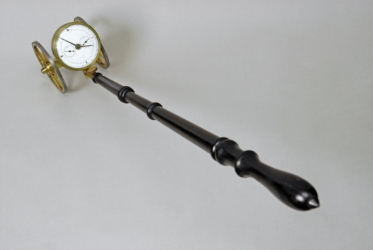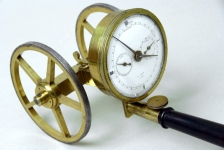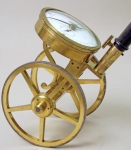Scientific Instrument Society 25th Anniversary Exhibition
Navigation:
<< First | < Previous | Next > | Last >>
13 Waywiser
It seemed strange to me that the dial should be such a long way from the handle and difficult to read. Would it not have been more sensible to have the dial at the top of the handle and connected to the wheels by a rod driven by a bevel gear, or am I not thinking in an eighteenth-century manner?
Private Collection, West Midlands, U.K.
A waywiser or perambulator, as George Adams called it, was used to measure distances by walking it along the road. This example is much more delicate than the instrument exhibited nearby, and may have been used to measure an estate, as it is optimistically graduated from inches to miles.
Adams did suggest that for steadiness, instruments with two wheels were available, but he was referring to large diameter wheels; this instrument, with its painted enamel dial, may be a further refinement for a particular customer.
It was made by George Adams Jnr (1750-1795) between 1784 and 1795 because the box is fitted with a lock patented in 1784 by Joseph Bramah (1748-1814).
An instrument of the form suggested by the owner was made about 1635 in Germany. Attributed to Hans and Christoph Schissler, it is now in the Istituto e Museo di Storia della Scienza, Florence, Inventory No. 3384.
P.D.
See: British Patent Specification No. 1430 of 1784
William Jones ed., George Adams, Geometrical and Graphical Essays, 2nd edition, London 1797, p. 209
Objects lent by Anonymous Lender II, West Midlands, UK:
04. Beam Compass, by George Adams, London, 1757-60
35. Silver Engine-Turned Box Sextant, by Troughton, London, c. 1810
37. Sextant, by Jesse Ramsden, London, c.1765
42. Hydrostatic Balance, by George Adams, London, c. 1760
50. Three Early Forms of Electro-Magnetic Demonstration Motor, English, c. 1835-40



